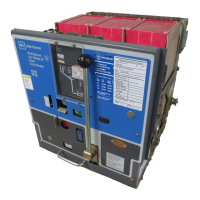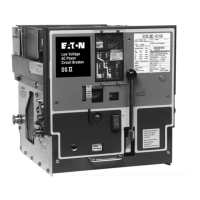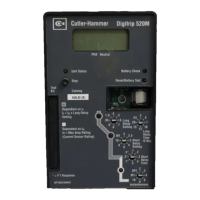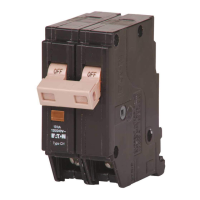1.8. 33-790-11
5.1.5
Circuit
Breaker Closing Mechanism
This mechanism is
of
the general variety
of
mechanically
trip-free mechanisms. This means that the breaker can
be opened
or
tripped free from the closing mechanism
at
any point
in
its closing stroke. It also means that if the trip
latch is held
in
the "trip" position while the spring release
latch is released, the closing springs will make a trip-free
operation but the breaker contacts will not close
or
move
appreciably toward the closed-position.
Based
on
this construction, the breaker close and trip
linkage can have four steady state conditions. The
arrangements
of
the basic close and trip linkage for these
four conditions are shown
in
Figures 22a, 22b, 22c, and
22d as follows:
Figure 22a Breaker Open, Springs Discharged, Trip
Latch Not Reset.
Figure 22b Breaker Open, Springs Charged, Trip Latch
Reset.
Figure 22c Breaker Closed, Springs Discharged.
Figure 22d Breaker Closed, Springs Charged.
The angular position
of
the close cam
in
Figure 22a cor-
responds to the angular position
of
the drive plates and
Page 25
closing spring crank arms shown
in
Figure 16b. The trip
latch is
in
the tripped position and it will reset to the
latched position at the end
of
the spring charging stroke.
The closing springs are charged by counterclockwise
rotation
of
the ratchet and drive plates until the close cam
stop roller meets the spring release latch, as shown
in
Figure 22b.
Note
in
Figure 22b also that the lower end
of
the main
drive link, with the main roller, has swung upward and
toward the left, pushing the trip latch constraining link so
as to rotate the trip latch back to the reset position. This
occurs
at
the same time that the spring charge is com-
plete and
just
before the close cam stop roller strikes the
spring release latch. The position
of
the cam
in
Figure
22b corresponds to the position
of
the drive plates
in
Fig-
ure 16a spring charged, breaker open.
The breaker is now ready to be closed. Closing is started
by
counterclockwise rotation
of
the spring release latch.
Refer again to Figure 22b. This removes the hold
on
the
close cam stop roller, and allows the force
of
the closing
springs to rotate the close cam counterclockwise and
close the breaker. The linkage is then
in
the position
shown
in
Figure 22c. The close cam has rotated about
180 degrees.
1.
Trip
Latch 7.
T~io.
Shaft Lever
2.
2J'r~i~flit61iffin
B~BTr~t~
_3.
RaUl!f._Coostalinigq,J..iD.lr..
-9....T~~~"
4
.~r~inee
0
1
Wl.-Mlni"\:l\'r91h:.iM.'·
..
~~TifhtAf~e
1111iT~bt\ilt.V~
~0~1ibnf"l"f1P'\,.'i51f'
•
Tr'lr11r
Ai:tuator
t;1J_Shunt~
Fig. 23 Shunt Trip Details Showing Trip Shaft Adjustment
Effective October 1998
Courtesy of NationalSwitchgear.com

